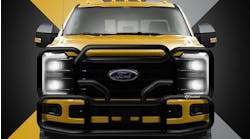WINSTON-SALEM, NC. Roughly five months into 2017, Volvo Trucks North America (VTNA) still thinks the North American Class 8 market will top 215,000 units for the year – truck production volume that is being driven in part by strong construction spending, which the OEM said is at its highest level since 2007.
Magnus Koeck, VTNA’s vice president of marketing and brand management, explained to journalists gathered here to test drive the OEM’s new VNR regional haul truck – introduced in Montreal back in April – that strong labor market and consumer spending will drive U.S. gross domestic product (GDP) growth this year, with moderate manufacturing growth expected as well, both of which in turn will help bolster Class 8 sales.
“Diesel prices are also low and the Department of Energy now expects just a 2.2% annual increase in diesel prices until 2040,” he added.
That doesn’t mean VTNA is looking at the commercial vehicle market through rose-colored glasses, however.
Koeck noted that the long haul segment is declining largely due to weak freight demand and rates, along with excess used truck inventories.
He added that looking at Class 8 registrations year to date though March of 2016 and 2017 side by side, “we see a drop in long haul from 46.8% to 41.2%.” Altogether, total Class 8 registrations dropped from 59,481 units year-to-date through March of 2016 to 45,856 units year-to-date through March of 201, according to VTNA data.
Meanwhile, the regional haul market is expected to remain flat in the U.S., Koeck noted, maintaining a consistent 28% of Class 8 market share, though there will be a continued trend towards freight "regionalization" spurred on in part by the growing driver shortage.
“For 2017 what we expect is that regional [demand] will stay balanced but flat,” he pointed out. “Yet there’s a change in transportation patterns towards less driving distances and less sleeper use. But we do expect long haul to pick up slightly at the end of the year.”
A few other truck trends Koeck highlighted during his talk included:
- Cheap diesel is delaying the growth of natural gas as a fuel source for the trucking industry.
- There’s been a recovery in the natural gas and oil field sector in the U.S. and that is translating into more tanker trucking demand.
- The recent expansion of the Panama Canal and U.S. ports is increasing container and intermodal traffic.
- There are more partnerships and expansions of LTL carriers between U.S. and Canada.
- Volvo engines now represent 92.5% of all the OEM’s truck builds, with the Volvo I-Shift automated manual transmission (AMT) spec’d for 90.2% of all Volvo truck builds.



